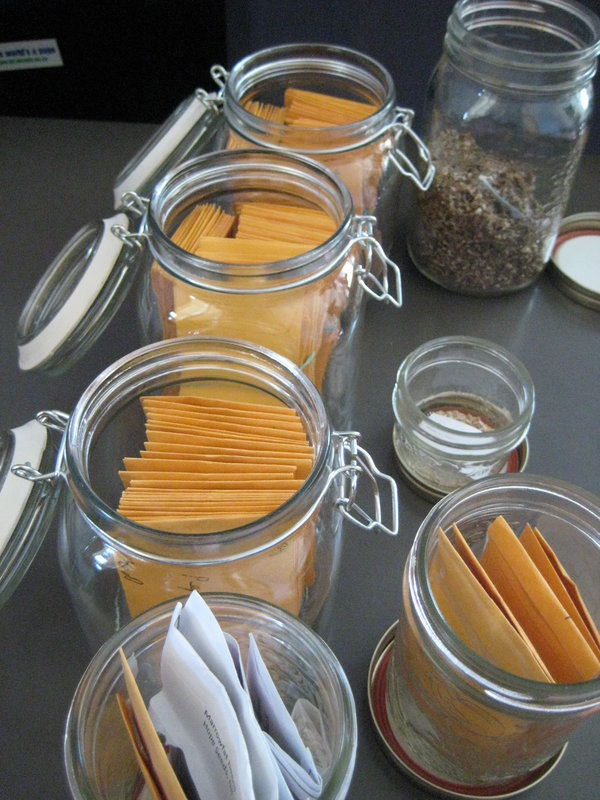Back to October 2017 Newsletter
6 Good and Bad Places to Store Your Seeds

Bob Wildfong
Whether you've saved seeds from your garden, or you have extra seeds from last spring, this is the time to make sure they're properly stored so they will germinate next year.
Seed storage is not difficult, but it makes the difference between seeds that last for years, and seeds that refuse to sprout after only a few months. The trick is to keep them dry and cold, and dry is more important than cold.
Seeds have little living plants inside, and a small amount of stored food. When they're warm and moist seeds get excited and ready to sprout, so they eat up their food quickly. When they're dry and cold they go dormant like hibernating animals, and eat their food slowly. The more dormant they are, the longer the food lasts, so the longer the seed stays alive and is able to sprout.
| Good storage | Bad storage | |
| Dry | Moist | More important |
| Cold | Warm | Less important |
So here are six good and bad places to store your seeds during the winter.
1. In the basement. (NO)
Usually, basements are fairly humid. Even if they are finished, most basements don't have the same ventilation as the upper floors of a house so moisture from the walls can enter the air. If you have any problems with water or humidity in your basement, that is definitely not a good place to keep your seeds.
2. In air-tight containers in the basement (YES)
Once your seeds are fully dry you can store them in a humid basement if they're in air-tight containers. Even if the basement is a bit humid, the dry air inside the containers plus the cool downstairs temperature should help your seeds to last a long time.
Glass jars are good for this, but plastic bags leak more air than you might expect so they aren't really good enough.
The important thing is to make sure the seeds are fully dried, for at least a month, before putting them in containers because any remnant of moisture can cause them to mould.
3. In the fridge (NO)
You might think a fridge would be a good place to keep seeds cold, but that can be a real mistake. Fridges are cold, but they're also very wet and humid. Even chilly seeds will expire quickly if they absorb moisture from such a humid place.
4. In a main-floor closet (YES)
The main floor of your house might not be as cool as the basement, but it is almost certainly drier. Since DRY is more important than COLD for seed longevity, a dry closet is a pretty good place.
5. In a heated garage (NO)
Maybe you have a garage built onto your house, where some warmth comes in during the winter. It's probably a convenient place to keep seeds, because it's handy to the garden and where you keep your tools. Unfortunately during winter those kind of garages tend to warm up when the door is closed, then suddenly cool down when the door is opened. That leads to condensation on all surfaces in the garage, including on your seeds. When they absorb the moisture, the seeds can lose some dormancy, but worse, they can be damaged if that moisture freezes.
6. In an unheated garage or shed (MAYBE)
Sometimes, an unheated garage or shed is a good place. As long as your seeds have been able to dry completely, they can freeze without a lot of damage. Since changes of temperature are gradual outdoors, there is less danger of condensation, and winter air tends to keep the seeds dry anyway. The important thing is make sure that the place stays dry. Or you can put your seeds in glass jars and let them freeze - as long as they're well dried when you seal the jars.
Also, be sure to protect your seeds from mice if you keep them in a shed!
There are lots of places where you can store seeds successfully, as long as you avoid humidity and moisture, and only put seeds in air-tight containers after they have had a least a month to fully dry out. If you can keep them dry and cold, that's perfect. If you can only find a place that's dry and warm, or moist and cold, then make sure you keep them dry at least. Then your seeds will sprout reliably in the spring, which makes saving your seeds worth the effort after all!
--
Bob Wildfong is Seeds of Diversity's executive director
Not yet a member?
An annual membership to Seeds of Diversity gives you access to our seed exchange, seed grow-out programs, and our online news.

We depend on donations to do our work.

Thank you for your support!
